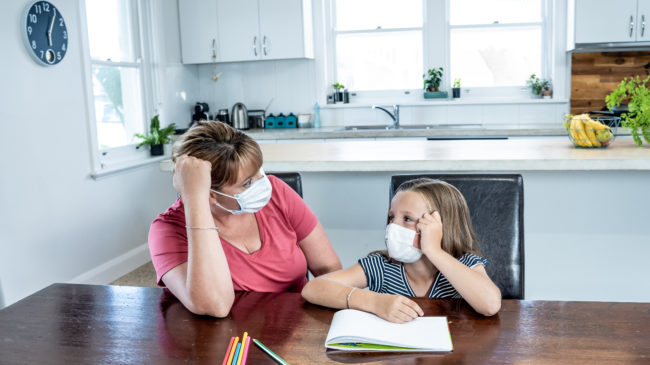In an attempt to mitigate the spread of COVID-19 through social distancing, schools have closed for nearly all K-12 students in the U.S., and at least 46 states have ordered or recommended closing schools for the rest of the academic year. These school closures have impacted over 55 million students from over 124,000 schools.
Although the pandemic has brought significant hardship to families and their children, the education system can adapt to COVID-19 and even end up working better for students in the future. Here’s how.
We’re essentially all homeschoolers now. In just a matter of weeks, the proportion of U.S. students who were homeschooling jumped from about 3 percent to nearly 100 percent of the school-aged population.
Many schools have been able to continue providing educational services to their students virtually. However, some school districts are not covering any new learning material — or any instruction at all — throughout the rest of the school year. And although many school districts have been technically providing continued instruction, some families may not be satisfied with the quality of those services. In these cases, families thankfully have some other options at their disposal.
Many Resources are Available to Families for Free
There is an abundance of online resources available to families to help them adapt to their children’s new home education experiences. Families can access instructional videos for free at websites such as Khan Academy and TED Ed, and over 13,000 families have been sharing many more helpful resources with each other at Learn Everywhere.
It is completely understandable that many families may not have the time to customize their children’s educations at the moment. Tuition-free public charter schools are available in 45 states and the District of Columbia, and many states offer access to virtual charter schools. These virtual charter schools have been virtually unaffected by the coronavirus pandemic since they were already providing education to their students from afar.
Although groups in some states have attempted to use government force to prevent families from switching to virtual charter schools during the shutdown, most states are allowing virtual charter schools to serve new students, and some providers of virtual education such as K-12 Inc. and StrongMind have been offering free services to students throughout the country. The state of Alaska even partnered with Florida Virtual School, a school that has been providing virtual education for over two decades, to help Alaskan students receive services during the shutdown.
Policymakers Can Help Families Adapt
Policymakers in all states can help families access virtual charter schools by relaxing or getting rid of regulations on enrollment deadlines, the maximum allowable student-to-teacher ratios, and by waiving standardized testing requirements. Policymakers should avoid following the responses by states like Oregon and Pennsylvania. Oregon prohibited students from switching into virtual charter schools and Pennsylvania is not compensating virtual charter schools for serving any of their new students during the crisis.
In fact, The Wall Street Journal reported that around 1,600 students have been blocked from enrolling in Oregon Connections Academy. These kinds of rules put the protection of government-run schools before the needs of families at the arguably worst time possible — a time when unemployment is skyrocketing and millions of families are financially struggling.
Education Choice Programs as Short- and Long-Term Solutions
States could also issue emergency education savings accounts to help families adjust to the closures. If a child’s residentially assigned government school is not working for them during the closure, for whatever reason, the child could use some of their education dollars to cover homeschooling expenses or to attend a private school of their choosing. The state could set the education savings account funding amount to a fraction of the amount that would have been spent on the child in the government school to create a win-win scenario for all parties involved: families would have more educational options and government schools would get to keep some portion of funding for children who no longer attend them.
States should consider keeping these education savings account programs in place even after brick-and-mortar schools reopen. Although the pandemic will cause some families to realize that they don’t like homeschooling, there will be some portion of families who will want to continue homeschooling their children.
In fact, a new nationally representative survey suggests that parents are actually more likely to support the practice of homeschooling as a result of COVID-19. Specifically, the new survey found that 52 percent of parents reported having a more favorable view of homeschooling, whereas only half that proportion reported having a less favorable view of homeschooling, as a result of COVID-19.
In systems without education savings accounts, the problem is that even if a family finds they really like homeschooling, they may not be able to continue the practice because of financial constraints.
In other words, low-income families would be disproportionately more likely to send their children back to government schools after the lockdown regardless of their preferences. In this sense, education savings accounts would lead to more equality in the education system since well-off families can already afford to incur the costs of homeschooling or pay for private schools out-of-pocket.
On average, the U.S. spends $15,424 per student per year of K-12 schooling. That money could go a long way with helping low-income families access home education, and it would be more than enough to cover tuition at the average private school. According to Private School Review, the average tuition of U.S. private schools is currently $11,012, or about 29 percent less than the amount spent in government schools per child.
That means, with a fully-funded education savings account program, a family could afford an average private school for their child and still have about $4,400 leftover each year to use towards other educational expenses such as tutoring, textbooks, and online learning. Policymakers could also structure education savings account programs to allow any leftover funding to rollover from year to year and ultimately be used for higher education.
Education savings account programs would allow families to customize their children’s educations and provide them with access to schools with strong incentives to meet their children’s needs.
In fact, a new online survey of 849 teenagers conducted by Common Sense Media and Survey Monkey found that students in private schools were over twice as likely as students in government schools to connect with their teachers each day since schools closed. The survey also found that private school students were 1.5 times as likely as students in government schools to attend online classes during the closures. These results make sense. Private school leaders know that they can lose their customers if they don’t cater to their needs.
Education savings accounts would also provide government schools with similar incentives to perform well. As the preponderance of the evidence shows, competition from private school choice programs generally leads to better educational outcomes for students who remain in government schools.
Let’s Fund Students, Not Systems
Families have experienced significant hardships with adapting to COVID-19 and the closures of brick-and-mortar schools. The good news is that millions of families already have access to virtual charter schools, online learning resources, and networks of parents sharing homeschooling tips. Policymakers have the power to provide more help to families by getting rid of unnecessary red tape and by expanding educational options.
The best way to do that is to allow children to take their education dollars to wherever they are receiving an education, whether that be in a government school, a charter school, a private school, or at home. In other words, states should fund students instead of systems.
A version of this column originally appeared on The Benchmark at Medium.com.

